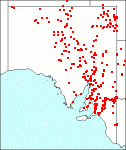Family: Lamiaceae
Teucrium racemosum
Citation:
R. Br., Prod. Fl. Nov. Holl. 504 (1810).
Synonymy: T. racemosum R. Br. var. triflorum J. Black, FI.S. Aust. 486 (1926).
Common name: Grey germander.
Description:
Perennial herbs to 60 cm tall, with a root stock often becoming somewhat woody and more or less suckering, with quadrangular stems usually ridged, densely covered with recurved appressed simple hairs usually wearing off along the ridges; leaves simple, sessile or subsessile, lanceolate to linear-lanceolate, 1-5 x 0.3-1.2 cm, acute, abruptly tapering into a short petiole-like cuneate base, with margins usually unevenly recurved and/or undulate, more or less densely hairy with simple hairs retrorse and usually somewhat denser on the undersurface.
Inflorescence a thyrse without a distinct peduncle, often branched at the base, with cymose part-inflorescences stalked, 1- or sometimes 3-flowered, with flower stalk divided into a peduncle and pedicel at the deciduous bracts, which are subulate, rarely scale-like and acute, each part-inflorescence subtended by leaf-like bracts which decrease upwards; sepals regularly connate for one-third to two-thirds of their length, 2-5 mm long, with acute lobes, densely covered with simple retrorse hairs and with scattered sessile glands; corolla white, l-lipped, with 2 posterior and 2 lateral lobes linear, subequal and shorter than the spathulate to oblanceolate central lobe, more or less densely covered with retrorse hairs and a few sessile glands outside and with long spreading hairs in the area around the stamens; stamens 4 fertile, inserted in the throat of the corolla tube, with filaments hairy at the base; anthers 2-celled, exserted and curved form posterior to anterior above the lip; ovary on a thick disk, scarcely 4-lobed, with a slender style inserted near the apex and curved like the stamens, with a 2-fid stigma.
Mericarps oblong-obovoid, 2-3 mm long, not keeled, with the attachment scar being a large concavity in the lower half of the inner surface, with spreading hairs sometimes only towards the apex and scattered sessile glands.

| Flowering branch.
|
Image source: fig. 558D in Jessop J.P. & Toelken H.R. (Ed.) 1986. Flora of South Australia (4th edn).
|
Published illustration:
Cunningham et al. (1982) Plants of western New South Wales, p. 577.
|
|
Distribution:
|
Often associated with temporarily flooded areas, usually on loam or clay soils.
S.Aust.: NW, LE, GT, FR, EA, EP, NL, MU, YP, SL, SE. All mainland States.
|
Conservation status:
native
Flowering time: mainly July — April.
|

SA Distribution Map based
on current data relating to
specimens held in the
State Herbarium of South Australia
|
Biology:
A widespread and variable species but plants with the smallest leaves and flowers are recorded from the fringes of the higher rainfall regions such as in SL, MU, SE. In more robust plants the inflorescence is often branched near the base and the part-inflorescences immediately above some-times produce up to 3 flowers.
Taxonomic notes:
Herbarium material is easily confused with Spartothamnella teucriiflora which is indistinguishable except for its linear leaves and drupaceous simple fruit.
Author:
Not yet available
|

